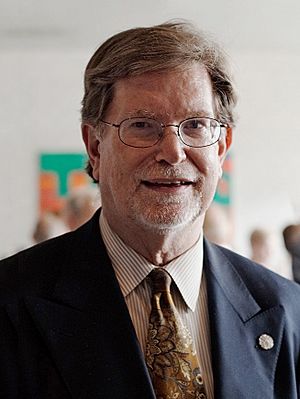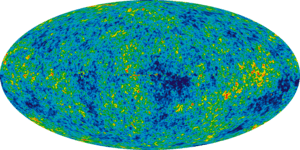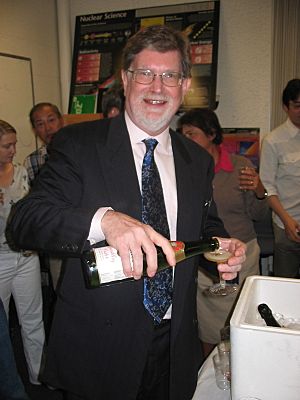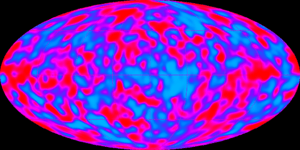George Smoot facts for kids
Quick facts for kids
George Smoot
|
|
|---|---|

Smoot at 2009 POVO conference in The Netherlands
|
|
| Born |
George Fitzgerald Smoot III
February 20, 1945 Yukon, Florida, U.S.
|
| Died | September 24, 2025 Paris, France
|
| Alma mater | Massachusetts Institute of Technology |
| Known for | Cosmic microwave background radiation |
| Awards | NASA Medal for Exceptional Scientific Achievement (1992) Kilby Award (1993) American Academy of Achievement Golden Plate Award (1994) E. O. Lawrence Award (1994) Albert Einstein Medal (2003) Nobel Prize in Physics (2006) Gruber Prize (2006) Daniel Chalonge Medal (2006) Oersted Medal (2009) |
| Scientific career | |
| Fields | Physics |
| Institutions | UC Berkeley/Lawrence Berkeley National Laboratory/Paris Diderot University/Hong Kong University of Science and Technology |
| Thesis | Charge exchange of positive Kaon on platinum at three GeV/C (1971) |
| Doctoral advisor | David H. Frisch |
| Physical cosmology | ||||||||||||||
 |
||||||||||||||
| Universe · Big Bang Age of the universe Timeline of the Big Bang Ultimate fate of the universe
|
||||||||||||||
George Fitzgerald Smoot III (February 20, 1945 – September 24, 2025) was an American scientist who studied space. He was an astrophysicist and cosmologist. He won the Nobel Prize in Physics in 2006. He was also famous for winning $1 million on the TV show Are You Smarter than a 5th Grader? Sadly, George Smoot passed away in Paris on September 24, 2025.
Smoot won the Nobel Prize with John C. Mather. They were honored for their work on the Cosmic Background Explorer (COBE) satellite. This project helped us understand the early universe. They discovered tiny differences in the cosmic microwave background radiation. This radiation is like an echo from the Big Bang. Their findings helped prove the Big Bang theory. The Nobel committee said COBE made cosmology a "precision science." Smoot gave his Nobel Prize money to charity.
He worked at the University of California, Berkeley for a long time. He also worked at the Lawrence Berkeley National Laboratory. Smoot received many awards for his scientific achievements. These included the NASA Medal and the Albert Einstein Medal. He was a respected member of the scientific community.
Contents
Growing Up and School
George Smoot was born in Yukon, Florida. He went to Upper Arlington High School in Ohio. After high school, he studied mathematics at the Massachusetts Institute of Technology (MIT). Later, he changed his focus to physics. He earned two degrees in math and physics in 1966. In 1970, he received his Ph.D. in particle physics. Fun fact: a distant relative, Oliver R. Smoot, inspired the unique unit of measurement called the smoot!
Exploring the Universe's Secrets
After his studies, George Smoot became very interested in cosmology. This is the study of the universe's origin and structure. He worked with Luis Walter Alvarez on an experiment. They used a special weather balloon high in the stratosphere. Their goal was to look for antimatter in space.
Smoot then focused on the cosmic microwave background radiation (CMB). This radiation is like a faint glow left over from the Big Bang. It was first found by Arno Allan Penzias and Robert Woodrow Wilson. Scientists wondered if the universe was spinning. If it was, the CMB's temperature would change depending on where you looked.
Smoot and his team built a special tool called a radiometer. They put it on a Lockheed U-2 plane. This tool measured tiny temperature differences in the CMB. They found that the universe was not spinning. But they did find something else! The CMB seemed a bit warmer on one side of the sky. This is called a dipole pattern. It happens because our Milky Way galaxy is moving very fast. It's moving at almost 600 kilometers per second! This movement creates a Doppler effect, like a siren sounding different as it moves past you. This motion is likely due to the pull of gravity from huge groups of galaxies.
The COBE Satellite Mission
Scientists knew the CMB was mostly smooth. But the universe today has many structures, like galaxies and galaxy clusters. These structures grew from tiny differences in the early universe. Smoot believed these tiny differences, called anisotropies, should be visible in the CMB. Finding them would be a huge step in understanding how the universe began.
In the late 1970s, Smoot proposed a project to NASA. He wanted to send a sensitive detector into space on a satellite. This detector would be even better than the one on the U-2 plane. NASA accepted his idea. It became part of the Cosmic Background Explorer (COBE) satellite mission. The COBE satellite cost $160 million.
COBE launched on November 18, 1989. It was delayed because of the Space Shuttle Challenger accident. After more than two years, the COBE team made an exciting announcement. On April 23, 1992, they revealed that COBE had found tiny temperature changes in the CMB! These "fluctuations" were like "wrinkles" in the fabric of space-time. They were the seeds from which all galaxies and stars eventually grew. This discovery was a huge breakthrough. Smoot famously said it was "like looking at God" for those who are religious.

The COBE mission was a massive team effort. Over 1,000 scientists and engineers worked together. John C. Mather led the overall project. Smoot was in charge of measuring the tiny temperature changes. This teamwork was key to COBE's success.
Smoot also wrote a book called Wrinkles in Time. It told the story of his team's discoveries. There was a small disagreement about how the news was shared. Smoot later apologized for not following the team's plan. But his actions also helped COBE get a lot of attention worldwide.
Continuing Space Exploration
After the COBE mission, Smoot kept working on understanding the CMB. He helped with other experiments. One was called Millimeter Anisotropy eXperiment IMaging Array. It used a balloon to get even clearer pictures of the CMB. He also worked on the Planck satellite, another advanced observatory.
Smoot helped design the Supernova/Acceleration Probe. This satellite aims to study dark energy. Dark energy is a mysterious force that makes the universe expand faster. He also used data from the Spitzer Space Telescope. This helped him study background radiation in space. In 2016, he helped launch the Mikhailo Lomonosov satellite.
Later in his career, Smoot explored new fields. He worked as an artificial intelligence scientist for the GTA Foundation. He also joined companies like Dead Sea Premier and Xiaomi. He helped them develop new technologies. In 2023, he joined a science council in Kazakhstan.
Smoot in the Media
George Smoot was not just a scientist; he was also a TV star! He made guest appearances as himself on the popular show The Big Bang Theory. He was a fan of the show's science themes. He even helped with a joke for one episode. He appeared in episodes like "The Terminator Decoupling" and "The Laureate Accumulation".
In 2009, Smoot won a huge prize on the game show Are You Smarter Than a 5th Grader? He answered the final question correctly: "What U.S. state is home to Acadia National Park?" The answer was Maine. He became the second person to win one million dollars!
He also gave a TEDx talk in 2014. In it, he talked about the idea that our reality might be like a computer simulation. This is called the simulation hypothesis. He even appeared in a TV commercial for TurboTax in 2016.
See also
 In Spanish: George Smoot para niños
In Spanish: George Smoot para niños


